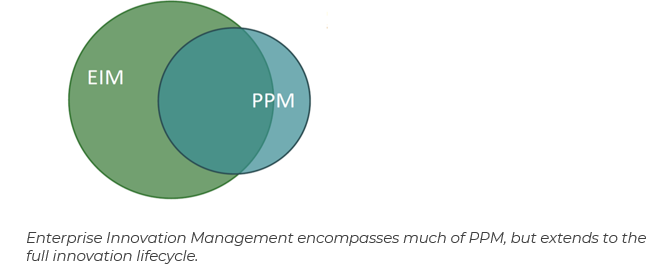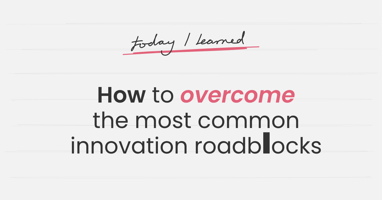Reading time: 5 minutes
PPM is necessary to maximize value within a given time horizon and ensure that the capital invested isn’t exposed to excessive market risk. It encompasses the selection, prioritization and control of an organization's programs and projects.
We talk a lot about Enterprise Innovation Management (EIM) and Project Portfolio Management (PPM), with many referring to the two as separate ideas, disciplines and enterprise software systems. However, for organizations looking to maintain a strong pipeline of innovative products, it's more accurate to view them as heavily overlapping.

We will apply a Jobs-To-Be-Done point of view to both EIM and PPM to see this overlap. The Jobs-To-Be-Done theory and framework focuses on people's "jobs" to accomplish their goals. The central idea is people and organizations buy products and services to get jobs done. This idea can be summed up in a quote from Theodore Levitt in a 1960 Harvard Business Review article: “People do not want a quarter-inch drill; they want a quarter-inch hole.”
As innovation and product professionals, understanding our teams' jobs helps us hone in on our processes, understand what might be getting in the way of innovation and understand where the tools we use are falling down.
A closer look at Enterprise Innovation Management (EIM)
EIM has many different definitions, but I think this description best frames how we should think about it:
Enterprise Innovation Management consists of the management of “jobs” that need to be performed by a range of people to drive the strategy, tactics, processes, and policies needed to grow and create value for the company and its customers.
In digging deeper, these facets also build a deeper understanding of EIM:
- The process of managing an organization's innovation process, starting at the initial stage of strategy and ideation through launch to end-of-product-life. It encompasses the decisions, activities and practices of devising and implementing an innovation strategy.
- Bringing together and keeping current the relevant information to ensure all participants, from those executing specific jobs and processes to critical stakeholders, can make informed decisions to meet strategic and tactical objectives. A single source of truth allows teams to work within a common understanding of different processes and goals.
- The active governance, monitoring and execution of company-wide activities, processes, and policies to create substantial new value for the company and its customers.
Using a Jobs-To-Be-Done framework, we’ve seen that there are five high-level—or as I like to say, aspirational—jobs that product and innovation professionals need to perform to drive innovation and product strategies forward:
- Managing strategic planning and execution
- Managing ideas
- Managing products
- Managing projects and resources
- Managing portfolios
While all are important, managing portfolios is a critical job that touches a number of areas in the innovation process.
How Product Portfolio Management (PPM) supports innovation strategy
With PPM, things can be a bit confusing because the acronym itself varies. In some cases, PPM stands for product portfolio management, which helps to prioritize between multiple products and ensure the right resources are assigned to the right products. Within this definition, PPM also helps to maintain a pipeline of new ideas and products at any given time.
Other times, PPM is, which is the centralized management of the processes, methods and technologies used by project managers and project management offices to analyze and collectively manage current or proposed projects based on numerous key characteristics throughout each project’s lifecycle.
Whether about products or projects, PPM is necessary to maximize value within a given time horizon and ensure that the capital invested isn’t exposed to excessive risk. It encompasses the selection, prioritization and control of an organization's programs and projects, in line with its strategic objectives and capacity to deliver, whether for products or projects.
We’ve seen that within PPM there are two critical aspirational jobs:
- Manage products or projects (depending on the definition of the first “P”)
- Manage portfolios
Take note that managing portfolios represents an important job within both EIM and PPM. Let’s take a closer look at tasks that fall under the managing portfolios umbrella:
- Define the portfolio. What products and projects are you working on and identify how they ladder up to the overall EIM strategy.
- Assess the portfolio. Determine which products and projects are succeeding and which ones aren’t going to meet expectations or launch on time. Look at how future trends may affect performance moving forward.
- Optimize the portfolio. Take a look at adjustments that can make the portfolio more streamlined and effective.
- Prioritize portfolio items. Consider products and projects that have been on backlog and determine whether it makes sense to move them forward or remove them from the queue.
- Update portfolio roadmap. Make sure timelines are still accurate and determine if products still relate to the organization’s overall strategic goals and initiatives.
- Monitor and address changes, risks and issues. Innovation is not a static process, and it’s essential to note situations that could increase portfolio risk. Having a solid innovation governance process in place helps to facilitate this job.
- Inform stakeholders. Innovation requires transparency and visibility to the process, so consistent positive or challenging updates are necessary to make informed decisions at the executive level.
Whether categized as EIM or PPM, jobs that fall under the manage portfolio category are consistent across organizations and tools employed to help team members get their work done. Not only does having a better understanding of these jobs help product and innovation professionals become more effective, but it also ensures that the systems and tools put in place support the larger EIM strategy and make them more efficient too.
To learn more about EIM and PPM and how they could support your innovation strategy, watch the recent webinar I hosted in conjunction with the Innov8rs community.






